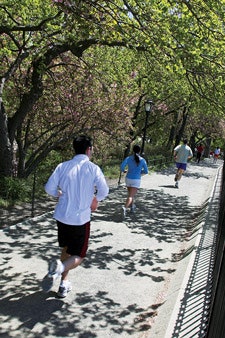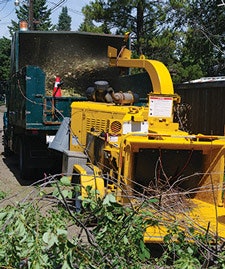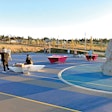When budgets need cutting, park maintenance and landscaping often take the hit before more public-centered programming, a decision that can end up costing more in the long run.

When budgets need cutting, park maintenance and landscaping often take the hit before more public-centered programming, a decision that can end up costing more in the long run. This summer, the San Francisco Recreation and Parks Department is beginning the second phase of a project to remove and replace more than 300 dead and unsafe trees in Golden Gate Park at a cost of $1.7 million, part of a $4 million bond passed in 2008 to create a citywide park forestry program. The program will take a more proactive approach to ensuring the health of new trees.
"We have an estimate of roughly 100,000 trees in our park system that have not received proper care since their planting decades ago," a spokeswoman for the department told the San Francisco Examiner. "With limited resources and funding, we have only been able to mitigate emergency tree disasters with our Urban Forestry Program for our daily operation."
It's about more than just keeping the parks healthy. Since 2008, falling branches in San Francisco parks have damaged more than 60 vehicles, injured four people and caused one death. Last year, New York City settled - for $4 million - a lawsuit brought by a woman severely injured when a tree branch fell in Central Park, further demonstrating how costly cuts to park maintenance can be.
There are solutions, such as making budget cuts elsewhere to save park budgets, increasing taxes or stepping up volunteer programs.
Better still, the Metro Parks Department in Louisville, Ky., is finding ways to turn park maintenance into a revenue-generator. Forestry and landscape manager Mesude Duyar was excited when a consultant from a renewable energy company inquired last year about the department's wood waste generation - the dead and fallen branches cleared from parks or generated by landscaping projects. The company, Recast Energy, was considering converting an unused power plant from coal to biomass, but first needed to know whether there was enough wood waste being generated in the Louisville area to sustain the plant. The company expects to consume about 75,000 tons of wood-based biomass each year, of which the parks department anticipates contributing a mere 600 to 1,000 tons.
"I don't think we're the biggest partner," says Duyar, referring to the logging companies, private contractors and landscaping businesses that will supply the bulk of the materials to fuel the plant. "But this is a great public/private partnership and a smart environmental move that pays off for our community."
Biomass Benefits

The Boulder County Parks and Open Spaces Department has access to enough wood waste - the department is responsible for maintaining 30,000 acres of forested land - to make an investment in its own biomass plant pay off. "We did a feasibility study and it came back looking very positive," says Resource Management Division manager Therese Glowacki. In 2005, the department built the second small-scale biomass plant in Colorado to heat its new five-building Parks and Open Space complex, saving the department about $20,000 a year, Glowacki estimates. The county has realized more savings since the installation of an additional biomass plant in 2010 that provides heat for the county jail.
The department thins the forest each year, generating 100 to 200 acres of wood waste, more than enough to sustainably provide energy for the biomass operations without even considering the supply generated by residents dropping off waste at the county's two community sort yards. "We've hardly made a dent in forest resources," says Glowacki, adding, "It'll take us 25 years to get to 5,000 acres. By then, we'll have more tree growth and have to go back and do second entries."
While falling limbs may be a danger in urban parks, unhealthy trees pose an even greater hazard for communities in Colorado: wildfires. "Our forests are in a pretty unhealthy state," says Glowacki. "We have areas that should have 30 to 40 trees per acre, but there are currently 2,000 to 3,000. And they're all tiny. These should have been big, beautiful fire-resistant ponderosa pine trees. When a fire hits in a forest like that, the trees can't resist."
Carbon Control
In the past, the county tried taking the wood generated by thinning and redistribute it to the forest floor as wood chips or piling and burning the wood. The former option wasn't good for forest health, and the latter was a recipe for disaster if a wildfire was able to get to burn piles before county workers, and it raised concerns about carbon pollution. "The biomass still generates carbon emissions, but in a controlled environment," says Glowacki. "From an air pollution standpoint, it's much better to burn in a controlled environment."
While Louisville's Metro Parks Department isn't as concerned about forest fires, it is concerned with keeping its wooded areas healthy and safe for use. And while the wood waste generated isn't enough to justify investment in a biomass plant, it still represents a sizable expense to the department. "When we remove tree branches, we can chip them up if they are less than 18 inches in diameter," says Duyar. Larger branches and logs are piled and stored, and once every year or two, the department hires a company to come in and grind the logs. "Looking at the history, it costs us $20,000 to $25,000 annually to grind those logs."
Now, Recast will come and collect that material, using its own equipment to chip the wood and transport it to their facility as usable fuel. Not only can the department cut the expense of renting equipment and performing the work itself from its budget, it also stands to gain some additional revenue from the deal. "They will also accept the wood chips we generate by our own operations," explains Duyar, referring to the smaller branches that the department is able to process itself. "Most of the time, we reuse them for our landscaping - mulch around trees, playground areas - but if we have excess mulch, they will take it. That could bring somewhere around $10,000 in revenue each year."
The partnership couldn't come at a better time. Duyar says the parks department is preparing to take on a challenge that will result in a lot of extra wood waste over the next few years: the emerald ash borer. "We found the insect last year in our area," she says. "Not this summer, but next summer I expect it's going to pick up. Within the next three to four years, we'll be removing our ash trees."
Once it starts, Duyar estimates that the department will be removing 300 to 400 ash trees per year from Metro Parks alone, not counting the other woodland areas around Louisville. "With our own personnel, we can handle the workload created by the EAB infestation," says Duyar. "Our main concern was how we would dispose of the waste wood."
Evolve and Educate
Glowacki has hopes of taking the county's wood waste resources even further in coming years. There's room for a third biomass plant if the county opts to build one, and Glowacki hopes to explore other uses for the wood scraps that aren't suitable for biomass. "Our ultimate goal would be that we could use any of the secondary stuff, the slash and chunk wood, to make biochar," she says.
Biochar is created by burning wood at a low temperature, resulting in a charcoal-like substance that, among other uses, can be used to enhance soil. "We would harvest the trees, turn them into biochar and return that to the land to help plants grow."
While Glowacki concedes that not every community has 30,000 acres of forest at its disposal, she thinks the potential results make it worthwhile for parks programs. "This is an ideal scenario," she says. "We have hundreds of miles of trails. It's a great education for our park users when they see us thinning and stop and ask why we're doing the thinning, where it goes, how it's used."
In Louisville, Duyar expects that the partnership with Recast will eventually be expanded to include other city departments. "I can't ask for a better agreement," she says. "It makes environmental and economic sense for both sides."

































